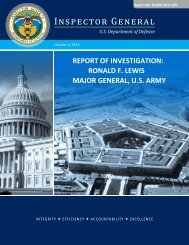Command Red Team
2gWzzvB
2gWzzvB
You also want an ePaper? Increase the reach of your titles
YUMPU automatically turns print PDFs into web optimized ePapers that Google loves.
EXECUTIVE SUMMARY<br />
COMMANDER’S OVERVIEW<br />
• Provides an Introduction to <strong>Command</strong> <strong>Red</strong> <strong>Team</strong><br />
• Explains <strong>Command</strong> <strong>Red</strong> <strong>Team</strong> Organization<br />
• Describes <strong>Red</strong> <strong>Team</strong> Challenges<br />
• Addresses <strong>Red</strong> <strong>Team</strong> Activities<br />
• Covers the <strong>Red</strong> <strong>Team</strong>’s Role in Joint Planning<br />
• Discusses the Relationship between <strong>Red</strong> <strong>Team</strong> and Joint Intelligence<br />
Introduction to <strong>Command</strong> <strong>Red</strong> <strong>Team</strong><br />
The command red team is a<br />
decision support element that<br />
provides an independent<br />
capability to fully explore<br />
alternatives in plans, operations,<br />
and intelligence analysis.<br />
The <strong>Command</strong> <strong>Red</strong> <strong>Team</strong> and<br />
Complementary Analytical<br />
Efforts<br />
<strong>Command</strong> red teams help commanders and staffs<br />
think critically and creatively; challenge<br />
assumptions; mitigate groupthink; reduce risks by<br />
serving as a check against complacency and<br />
surprise; and increase opportunities by helping the<br />
staff see situations, problems, and potential<br />
solutions from alternative perspectives.<br />
The distinguishing feature of a command red team<br />
from alternative analysis produced by subject<br />
matter experts within the intelligence directorate<br />
of a joint staff is its relative independence, which<br />
isolates it from the organizational influences that<br />
can unintentionally shape intelligence analysis,<br />
such as the human tendency for analysts to<br />
maintain amicable relations with colleagues and<br />
supervisors, and the potential for regular<br />
coordination processes to normalize divergent<br />
assessments. <strong>Command</strong>ers can seek the<br />
perspectives of trusted advisors regarding any<br />
issue of concern. A command red team may also<br />
address similar issues, but unlike most<br />
commander’s advisory/action groups, it supports<br />
the commander’s staff throughout the design,<br />
planning, execution, and assessment of<br />
operations, and during routine problem-solving<br />
initiatives throughout the headquarters. <strong>Red</strong><br />
teams and tiger teams may be ad hoc and address<br />
v



